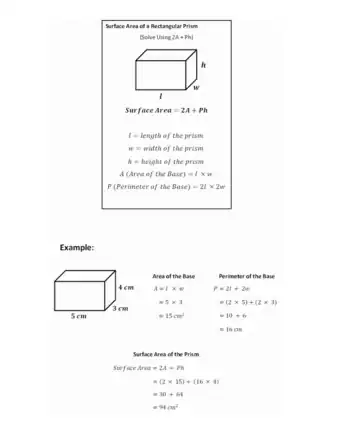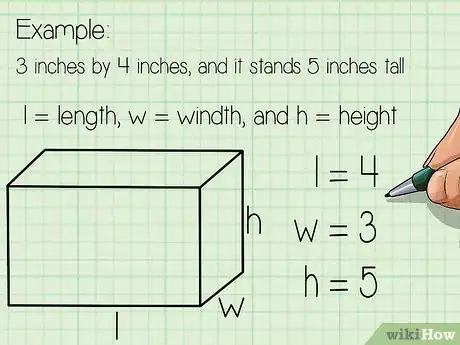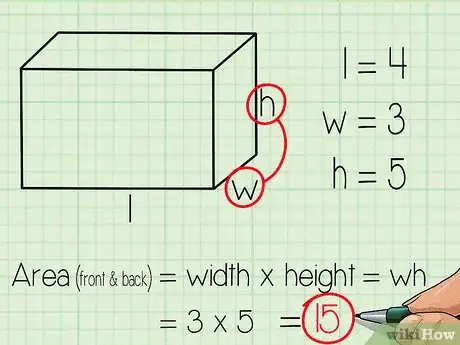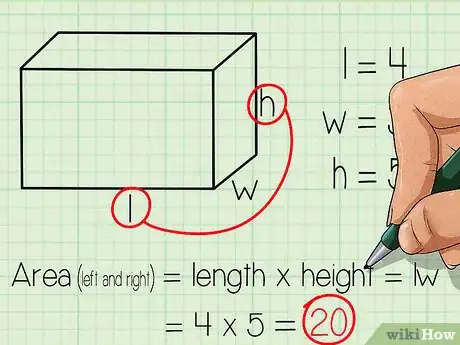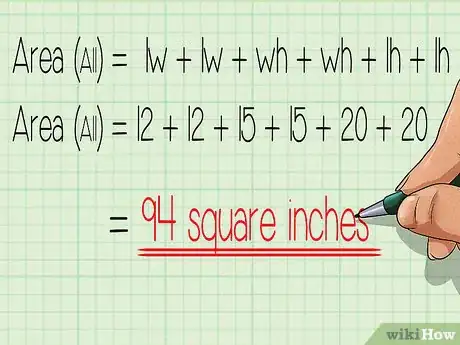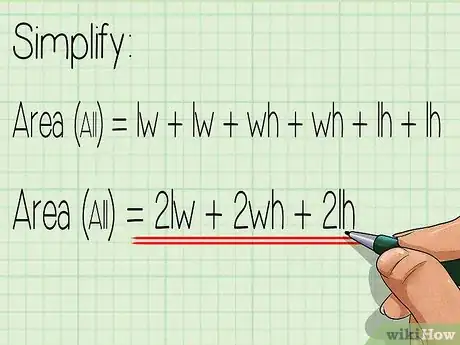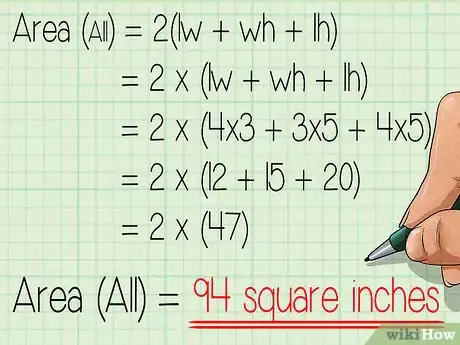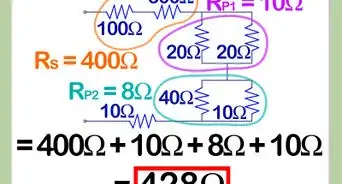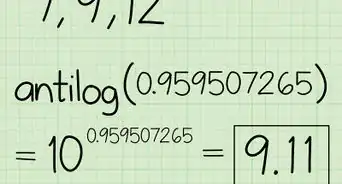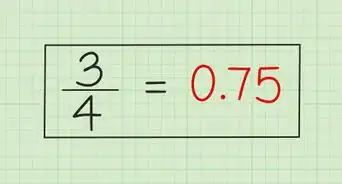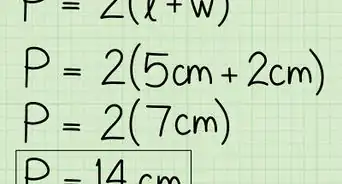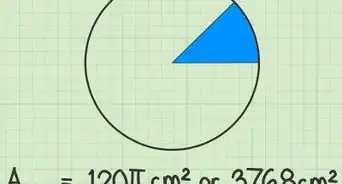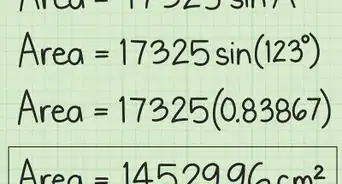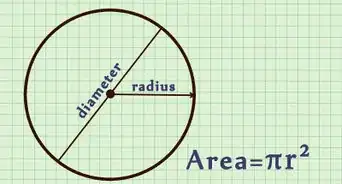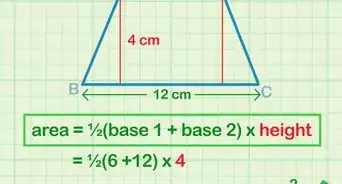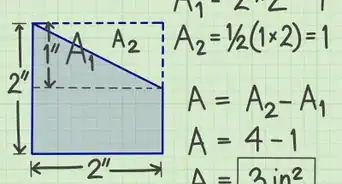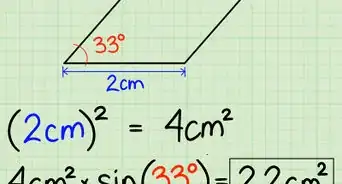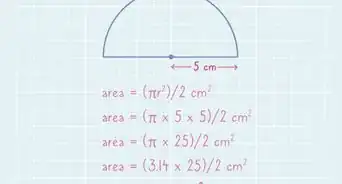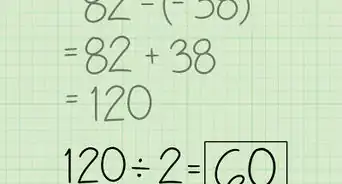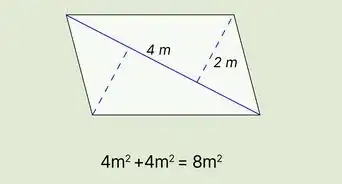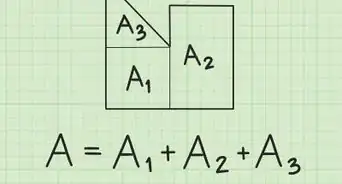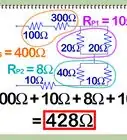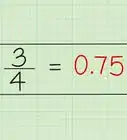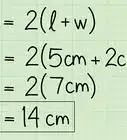wikiHow is a “wiki,” similar to Wikipedia, which means that many of our articles are co-written by multiple authors. To create this article, 83 people, some anonymous, worked to edit and improve it over time.
There are 9 references cited in this article, which can be found at the bottom of the page.
This article has been viewed 1,167,723 times.
Learn more...
A rectangular prism is a name for a 6-sided 3-dimensional figure that is very familiar to everybody—a box.[1] Think of a brick, or a shoebox, and you know exactly what a rectangular prism is. The surface area is the amount of space on the outside of the object. "How much paper do I need to wrap this shoebox" sounds a lot less complicated, but it's exactly the same math problem.
Steps
Surface Area Help
Finding the Surface Area
-
1Label the length, width, and height of your rectangular prism. Each rectangular prism has a length, a width, and a height. Draw a picture of the prism, and write the symbols l, w, and h next to three different edges of the shape.[2]
- If you're not sure which sides to label, pick any corner. Label the three lines that meet at that corner.
- For example: A box has a base that measures 3 inches by 4 inches, and it stands 5 inches tall. The long side of the base is 4 inches, so l = 4, w = 3, and h = 5.
-
2Look at the six faces of the prism. To cover the whole surface area, you'd need to paint six different "faces." Think about each one — or find a box of cereal and look at them directly:[3]Advertisement
-
3Find the area of the bottom face. To start out, let's find the surface area of just one face: the bottom. This is a rectangle, just like every face. One edge of the rectangle is labeled length and the other is labeled width. To find the area of the rectangle, just multiply the two edges together.[6] Area (bottom edge) = length times width = lw.
- Going back to our example, the area of the bottom face is 4 inches x 3 inches = 12 square inches.
-
4Find the area of the top face. Wait a second — we already noticed that the top and bottom faces are the same size. This must also have an area of lw[7] .
- In our example, the top area is also 12 square inches.
-
5Find the area of the front and back faces. Go back to your diagram and look at the front face: the one with one edge labeled width and one labeled height. The area of the front face = width times height = wh. The area of the back is also wh.
- In our example, w = 3 inches and h = 5 inches, so the area of the front is 3 inches x 5 inches =15 square inches. The area of the back face is also 15 square inches.
-
6Find the area of the left and right faces. We've just got two faces left, each the same size. One edge is the length of the prism, and one edge is the height of the prism. The area of the left face is lh and the area of the right face is also lh.
- In our example, l = 4 inches and h = 5 inches, so the area of the left face = 4 inches x 5 inches = 20 square inches. The area of the right face is also 20 square inches.
-
7Add the six areas together. Now you've found the area of each of the six faces. Add them all together to get the area of the whole shape: lw + lw + wh + wh + lh + lh. You can use this formula for any rectangular prism, and you will always get the surface area.[8]
- To finish our example, just add up all the blue numbers above: 12 + 12 + 15 + 15 + 20 + 20 = 94 square inches.
Making the Formula Shorter
-
1Simplify the formula. You now know enough to find the surface area of any rectangular prism. You can do it faster if you've learned some basic algebra. Start with our equation above: Area of a rectangular prism = lw + lw + wh + wh + lh + lh. If we combine all the terms that are the same, we get:[9]
- Area of a rectangular prism = 2lw + 2wh + 2lh
-
2Factor out the two. If you know how to factor in algebra, you can make it even shorter:[10]
- Area of a Rectangular Prism = 2lw + 2wh + 2lh = 2(lw + wh + lh).
-
3Test it on an example.[11] Let's go back to our example box, with length 4, width 3, and height 5. Plug these numbers into the formula:
- Area = 2(lw + wh + lh) = 2 x (lw + wh + lh) = 2 x (4x3 + 3x5 + 4x5) = 2 x (12 + 15 + 20) = 2 x (47) = 94 square inches. That's the same answer we got before. Once you've practiced doing these equations, this is a much faster way to find the surface area.
Community Q&A
-
QuestionHow do I find the surface area of one with no length or is represented by x?
 DonaganTop AnswererMultiply x by the width and then by the height.
DonaganTop AnswererMultiply x by the width and then by the height. -
QuestionHow do I find the edge lengths for a rectangular prism with a surface area of 92 m?
 DonaganTop AnswererYou can't find them without having additional information.
DonaganTop AnswererYou can't find them without having additional information. -
QuestionHow do I find the total surface area of a triangular prism?
 Community AnswerStart off with the formula for the area of a triangle: 1/2bh = a (One half of base times height equals area.) Also, you'll need to know how to find the area of a rectangle, lw = a (length times width equals area.) Make a net of the prism. If the length and width of the prism are say, l = 4 and w = 6, the bottom rectangle in the center should be 4 x 6 (area = 24 sq. units.). Next, do the other two rectangles (Cheat: They're always the same area as the base!) Now, find the area of the triangle. Say the height = 4. We know w = 6, so we multiply 4 x 6. Now we multiply that by 1/2 (divide by 2). Do the same for the other one, then add them up.
Community AnswerStart off with the formula for the area of a triangle: 1/2bh = a (One half of base times height equals area.) Also, you'll need to know how to find the area of a rectangle, lw = a (length times width equals area.) Make a net of the prism. If the length and width of the prism are say, l = 4 and w = 6, the bottom rectangle in the center should be 4 x 6 (area = 24 sq. units.). Next, do the other two rectangles (Cheat: They're always the same area as the base!) Now, find the area of the triangle. Say the height = 4. We know w = 6, so we multiply 4 x 6. Now we multiply that by 1/2 (divide by 2). Do the same for the other one, then add them up.
References
- ↑ https://www.mathsisfun.com/definitions/rectangular-prism.html
- ↑ https://flexbooks.ck12.org/cbook/ck-12-interactive-middle-school-math-7-for-ccss/section/6.5/related/lesson/surface-area-of-rectangular-prisms-msm7/
- ↑ https://www.cuemath.com/geometry/rectangular-prism/
- ↑ http://www.math.com/tables/geometry/surfareas.htm
- ↑ http://education.seattlepi.com/surface-area-rectangular-prism-fifth-graders-5826.html
- ↑ https://www.cuemath.com/measurement/surface-area-of-rectangular-prism/
- ↑ https://www.cuemath.com/measurement/surface-area-of-rectangular-prism/
- ↑ https://www.cuemath.com/measurement/surface-area-of-rectangular-prism/
- ↑ https://flexbooks.ck12.org/cbook/ck-12-interactive-middle-school-math-7-for-ccss/section/6.5/related/lesson/surface-area-of-rectangular-prisms-msm7/
- ↑ https://www.calculatorsoup.com/calculators/geometry-solids/rectangularprism.php
- ↑ https://flexbooks.ck12.org/cbook/ck-12-interactive-middle-school-math-7-for-ccss/section/6.5/related/lesson/surface-area-of-rectangular-prisms-msm7/
- ↑ https://www.khanacademy.org/math/pre-algebra/measurement/area-basics/v/introduction-to-area-and-unit-squares
- ↑ http://thinkmath.edc.org/resource/measurement-length-width-height-depth
About This Article
To find the surface area of a rectangular prism, measure the length, width, and height of the prism. Find the area of the top and bottom faces by multiplying the length and width of the prism. Then, calculate the area of the left and right faces by multiplying the width and height. Finally, find the area of the front and back faces by multiplying the length and height of the prism. To find the surface area, simply add all 6 of these areas together and write your result in square units. If you want to learn how to simplify your formulas to make them easier to remember, keep reading the article!

